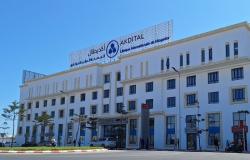By
Jessie Leclerc
Published on
May 31, 2024 at 7:44 a.m.
; updated May 31, 2024 at 7:47 a.m.
See my news
Follow 76-
Since 2021, the Groupe Hospitalier du Havre (GHH) has been collaborating with the company Incepto For to integrate artificial intelligence (AI) in the service of medical imaging. Objective: to screen breast, lung and prostate cancers as soon as possible.
Faster
Medical imaging is at the center of the fight against cancer. With the integration of AI into radiology services breast, pulmonology and urologythe GHH can act faster.
Artificial intelligence, in the hands of caregivers, saves time. It’s more precise, more specific. It detects more cancers and there are fewer false diagnoses,
Delayed treatment of cancers is an obstacle to recovery. “Lung cancer, the deadliest, is an unfavorable cancer because it is often detected late. We are at 20% survival at 5 years whereas with detection at stage 1, we would be at 90% survival. » confides Doctor Marie-Hélène Marques, pulmonologist.
“AI makes it possible to discover nodules earlysometimes fortuitously, because it sees things that we cannot see with the naked eye and I strongly believe in AI to help us act faster and sooner.”
“I know that AI is the future”
An undeniable advantage of artificial intelligence, is its precision. Doctor Farzaneh Quieffin, a radiologist specializing in women’s imaging, takes this as an example: “I had not seen an extremely subtle anomaly, on a breast, that the AI noticed. I wouldn’t have seen this cancer without that.”
I didn’t believe it at first, but we jumped on the bandwagon and now I know that AI is the future. We detect 3 to 4% more cancers nationally with AI. In addition, 3 to 4 women out of 100 can be treated.
Mehdi Soudani, urological surgeon, goes in the same direction: “The prostate is a chestnut of three or four centimeters where it can be hard to see things. AI helps detect connections and put them in boxes. »
Safer
Combining observations with artificial intelligence also means make fewer mistakes. According to Dr. Quieffin, “AI reduces the risk of false negatives. It is 99.98% effective.”
When you see 40,000 images per day, there is a risk of error. This risk is reduced by artificial intelligence,
Don’t panic about your personal data: “The information passes through a single channel, from the hospital to the AIInceptoand exchanges are faster, which provides real cybersecurity » claims the director of Le Havre hospital.
The doctor has more time to explain better
In oncology, time is precious. The hours saved with the use of AI are “useful time for the patient, to hold their hand, be there and explain to them better,” smiles Doctor Quieffin.
People understand better with the image that we compare with that of the AI. We explain to them the things that the AI sees.
Illustrate with imagesthis is the main asset of artificial intelligence for communication with the patient, as expressed by Doctor Soudani: “The patient affected by prostate cancer […] he can’t put an image on it. A picture is worth more than 1000 words. »
Le Havre, a place of concentration of certain cancers
There is a real need in Le Havre in terms of cancer due to polluting industries and a high rate of smokers: “we have a major public health problem due to an aging population and predispositions linked to a certain number of co-factors such as industry and tobacco” explains the co-founder ofIncepto. And added “It even happens among young people. You have to know how to act quickly and early in the illness“.
How much does it cost ?
This system cost the hospital 25,000 euros per year in 2022, 65,000 euros in 2024. For the director of the GHH, “it’s expensive and not expensive, because what is the cost of poor detection? And it’s is effective.” Other uses of AI are already planned.
See everything
For the doctors interviewed and the director of the GHH, AI is not to be feared. “ It will not replace either the radiologist’s interpretation or ours., but it will allow us to adjust, because there are as many progressive forms as there are patients,” thinks Doctor Marques. For her, “you must always compare to previous exams present in the software”.
This is a false debate, artificial intelligence will not replace humans, but it is in tune with the times.
According to Martin Treclat, “AI in imaging is the conjunction between doctors and technology”. One no longer goes without the other.
“AI is not going to make doctors disappear, on the other hand, a doctor who does not use AI is condemned to disappear,” concludes Gaspar d’Assignies.
Follow all the news from your favorite cities and media by subscribing to Mon -.







